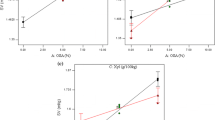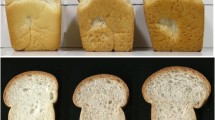Abstract
The protein content of ordinary white bread ranges from 8% to 9%. Specialty breads can be made with 13–16% protein by including soy protein. However, incorporating high levels of soy protein depresses loaf volume, gives poor crumb characteristics, and decreases acceptability. The objective of this study was to determine the influence of sodium stearoyl-2-lactylate (SSL), transglutaminase (TG), and xylanase (HE) on high-protein dough properties and bread quality and to improve dough handling and bread quality of soy–wheat bread by using an optimized additive combination. The influence of SSL, TG, and HE on soy–wheat dough and bread properties was modeled by response surface methodology. The negative effect of soy products on gluten network was confirmed. With regards to the additives tested and their combination, TG showed a major improving effect on dough rheological properties and crumb uniformity, whereas SSL and HE enhanced both dough and bread quality. The best formulation tested produced an increment of approximately 65% soy–wheat bread volume and a decrease of 79% and 71% crumb hardness and chewiness, respectively, compared with the standard formulation.





Similar content being viewed by others
References
American Association of Cereal Chemists (AACC) (1995). Approved methods of the AACC. Methods, 14–22, 54–30A. St. Paul, USA: American Association of Cereal Chemists.
Autio, K., Kruus, K., Knaapila, A., Gerber, N., Flander, L., & Buchert, J. (2005). Kinetics of transglutaminase-induced cross-linking of wheat proteins in dough. Journal of Agricultural and Food Chemistry, 53(4), 1039–1045.
Babiker, E. (2000). Effect of transglutaminase treatment on the functional properties of native and chymotrypsin-digested soy protein. Food Chemistry, 70(2), 139–145.
Basman, A., Koksel, H., & Ng, P. (2002). Effects of increasing levels of transglutaminase on the rheological properties and bread quality characteristics of two wheat flours. European Food Research and Technology, 215(5), 419–424.
Basman, A., Köksel, H., & Ng, P. (2003). Effects of transglutaminase on SDS-PAGE patterns of wheat, soy, and barley proteins and their blends. Journal of Food Science, 67(7), 2654–2658.
Bauer, N., Koehler, P., Wieser, H., & Schieberle, P. (2003). Studies on effects of microbial tranglutaminase on gluten proteins of wheat. II. Rheological properties. Cereal Chemistry, 80(6), 787–790.
Courtin, C. M., & Delcour, J. A. (2002). Arabinoxylans and endoxylanases in wheat flour bread-making. Journal of Cereal Science, 35(3), 225–243.
Courtin, C. M., Gelders, G. G., & Delcour, J. A. (2001). Use of two endoxylanases with different substrate selectivity provides insight into the functionality of arabinoxylans in wheat flour bread-making. Cereal Chemistry, 78(5), 564–571.
Every, D., Gerrard, J., Gilpin, M., Ross, M., & Newberry, M. (1998). Staling in starch bread: The effect of gluten additions on specific loaf volume and firming rate. Starch/Stärke, 50(10), 443–446.
Ferreira, S., Bruns, R., Ferreira, H., Matos, G., David, J., Brandao, G., et al. (2007). Box–Behnken design: An alternative for the optimization of analytical methods. Analytica Chimica Acta, 597(2), 179–186.
Fleming, S., & Sosulski, F. (1978). Microscopic evaluation of bread fortified with concentrated plant proteins. Cereal Chemistry, 55(3), 373–382.
Gerrard, J., Fayle, S., Wilson, A., Newberry, M., Ross, M., & Kavale, S. (1998). The effect of microbial transglutaminase on dough properties and crumb strength of white pan bread. Journal of Food Science, 63(3), 472–475.
Kamel, B., & Ponte, J. (1993). Emulsifiers in baking. In Kamel, & Stauffer (Eds.) Advances in baking technology (pp. 179–222). New York, USA: VCH.
Larré, C., Denery-Papini, S., Popineau, Y., Deshayes, G., Desserme, C., & Lefebvre, J. (2000). Biochemical analysis and rheological properties of gluten modified by transglutaminase. Cereal Chemistry, 77(2), 121–127.
Maforimbo, E., Nguyen, M., & Skurray, G. (2006). The effect of l-ascorbic acid on the rheological properties of soy–wheat dough: A comparison of raw and physically modified soy flours. Journal of Food Engineering, 72(4), 339–345.
Motoki, M., & Seguro, K. (1998). Transglutaminase and its use for food processing. Trends in Food Science & Technology, 9(5), 204–210.
Oates, C. G. (2001). Bread microstructure. In Chinachoti, & Vodovotz (Eds.) Bread staling (pp. 149–162). Boca Raton, USA: CRC.
Ribotta, P. D., Arnulphi, S., León, A. E., & Añón, M. C. (2005). Effect of soybean addition on the rheological properties and breadmaking quality of wheat flour. Journal of the Science of Food and Agriculture, 85(11), 1889–1896.
Rosell, C. M., Wang, J., Aja, S., Bean, S., & Lookhart, G. (2003). Wheat flour proteins as affected by transglutaminase and glucose oxidase. Cereal Chemistry, 80(1), 52–55.
Seguro, K., Kumazawa, Y., Kuraishi, C., Sakamoto, H., & Motoki, M. (1996). The e-(g-glutamyl)lysine moiety in crosslinked casein is an available source for lysine for rats. The Journal of Nutrition, 126(10), 2557–2562.
Suchy, J., Lukow, O. M., & Ingelin, M. E. (2000). Dough microextensibility method using a 2-g mixograph and a texture analyzer. Cereal Chemistry, 77(1), 39–43.
Tamstorf, S., Jonsson, T., & Krog, N. (1986). The role of fats and emulsifiers in baked products. In Blanshard, Frazier, & Galliard (Eds.) Chemistry and physics of baking (pp. 75–88). London, UK: The Royal Society of Chemistry.
Wang, M. W., Oudgenoeg, G., van Vliet, T., & Hamer, R. (2003). Interaction of water unextractable solids with gluten protein: Effect on dough properties and gluten quality. Journal of Cereal Science, 38(1), 95–104.
Wang, M., van Vliet, T., & Hamer, R. J. (2005). How gluten properties are affected by pentosans. Journal of Cereal Science, 39(3), 395–402.
Zghal, C., Scanlon, M., & Sapirstein, H. (2000). Relationship between bread crumb texture and crumb grain uniformity determined by digital image analysis. In: 85th Annual Meeting of American Association of Cereal Chemists, Kansas City, USA.
Zghal, M., Scanlon, M., & Sapirstein, H. (2001). Effects of flour strength, baking absorption, and processing conditions on the structure and mechanical properties of bread crumb. Cereal Chemistry, 78(1), 1–7.
Acknowledgments
The authors would like to thank the Laboratorio de Idiomas (FCA-UNC) for providing useful suggestions to improve the English language in this paper, and both the Consejo Nacional de Ciencia y Técnica (CONICET) and the Agencia Nacional de Promoción Científica y Tecnológica (ANPCyT) for the financial support.
Author information
Authors and Affiliations
Corresponding author
Rights and permissions
About this article
Cite this article
Ribotta, P.D., Pérez, G.T., Añón, M.C. et al. Optimization of Additive Combination for Improved Soy–Wheat Bread Quality. Food Bioprocess Technol 3, 395–405 (2010). https://doi.org/10.1007/s11947-008-0080-z
Received:
Accepted:
Published:
Issue Date:
DOI: https://doi.org/10.1007/s11947-008-0080-z




